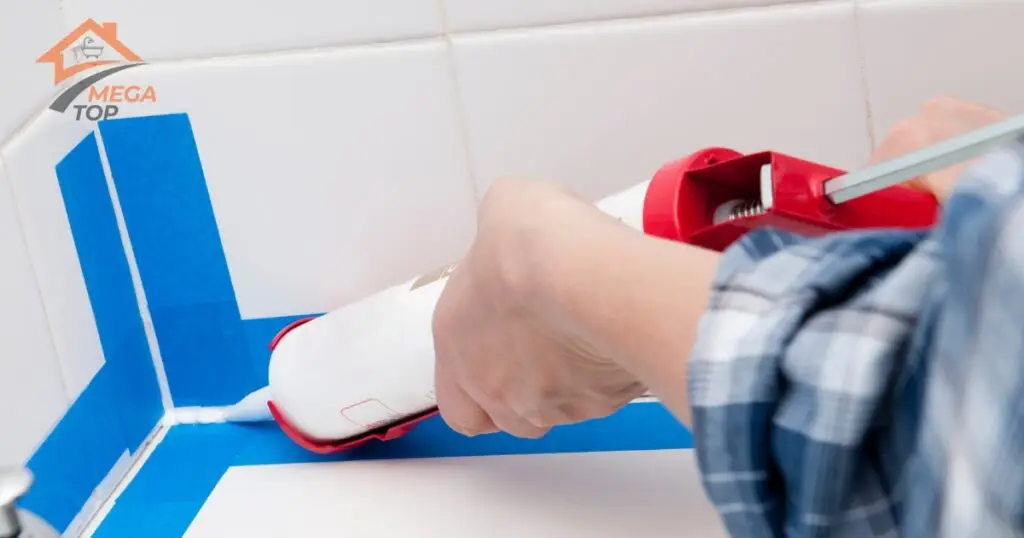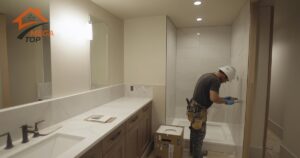Choosing the Right Bathroom Caulk
When sealing your bathroom, choosing the correct type of caulk is essential. Bathroom caulk protects against water leaks and mold, ensuring a watertight and durable seal around fixtures, tiles, and joints.
Silicone vs Acrylic Caulk
Pros and Cons of Silicone
Silicone caulk is the preferred choice for most bathroom sealing projects due to its superior water resistance and flexibility. It creates a long-lasting, watertight seal, making it ideal for areas like showers, tubs, and sinks. However, silicone caulk can be more challenging to apply and clean up compared to acrylic caulk, as it requires mineral spirits for removal.
Pros and Cons of Acrylic
Acrylic caulk is easier to apply and clean with soap and water, making it suitable for cosmetic fixes or non-wet areas. However, it doesn't offer the same level of water resistance as silicone, and it can crack or peel over time when exposed to moisture.
Mold-Resistant Caulk Options
Many bathroom caulks are now formulated with mold-resistant properties. These options are ideal for preventing mold and mildew growth, especially in high-moisture areas like showers and around bathtubs. Look for caulk labeled as "mildew-resistant" or "anti-mold" for the best protection.
How to Properly Seal Bathroom Tiles
Properly sealing bathroom tiles helps prevent water from seeping through gaps, which can lead to water damage over time.
Prepping the Tile Surface
Before applying caulk, ensure the tile surface is clean and dry. Remove any old caulk or debris using a utility knife or caulk remover. Clean the area with rubbing alcohol to ensure the new caulk adheres well.
Applying the Caulk for Watertight Sealing
Apply a continuous bead of caulk along the seams where the tiles meet other surfaces, such as walls, bathtubs, or shower doors. Smooth the caulk with a damp finger or a caulking tool for a neat finish. Allow the caulk to dry for at least 24 hours before exposing it to water.
Sealing Shower Joints and Corners
Showers are high-moisture areas where leaks can easily develop if the joints and corners are not properly sealed.
Common Leak Points in Showers
Leak-prone areas in the shower include where the walls meet the shower floor, around faucets, and along shower doors. These areas are particularly vulnerable to water seepage if not sealed correctly.
Step-by-Step Guide to Caulking Shower Joints
- Clean the joints and remove any old caulk.
- Apply a thin, continuous bead of silicone caulk to the joints and corners.
- Use a caulking tool or your finger to smooth the bead.
- Let the caulk cure for 24 hours before using the shower.
How to Seal Bathtub Edges
Sealing the edges of the bathtub is crucial for preventing water from seeping between the tub and the wall, which can cause water damage and mold growth.
Importance of Sealing Bathtubs
Bathtub edges are constantly exposed to water, so sealing them properly helps prevent water damage behind the tub, which can lead to costly repairs.
How to Ensure a Lasting Seal Around the Tub
After cleaning the area, apply a bead of silicone caulk along the bathtub edge where it meets the wall. Smooth the caulk and ensure it fills any gaps. Allow it to dry fully before exposing it to moisture.
Preventing Mold and Mildew with Proper Sealing
Moisture in bathrooms can quickly lead to mold and mildew growth, which not only looks unsightly but can also cause health issues.
Best Practices for Mold-Resistant Seals
Using mold-resistant caulk in all wet areas, such as around showers, sinks, and bathtubs, is essential. Ensure that all gaps are filled and there are no areas where moisture can collect.
Maintenance Tips for Caulked Areas
Regularly inspect caulked areas for signs of cracking, peeling, or mold growth. Clean caulk lines with mild soap and water to prevent mildew buildup.
How to Avoid Water Damage with Bathroom Caulking
Proper caulking is key to preventing water damage, which can lead to structural problems in your bathroom.
Key Areas to Focus on for Water Damage Prevention
Focus on areas around sinks, bathtubs, showers, and toilets. Sealing these areas properly prevents water from seeping into cracks and causing long-term damage.
Common Mistakes to Avoid When Sealing a Bathroom
Avoid using the wrong type of caulk, such as acrylic in high-moisture areas. Ensure that the caulk is applied smoothly and consistently to prevent gaps or air bubbles that can allow water in.
Sealing Bathroom Fixtures: Sinks, Toilets, and More
Bathroom fixtures like sinks and toilets also need proper sealing to prevent leaks and maintain cleanliness.
Caulking Around Sinks and Countertops
Use silicone caulk to seal the gap where the sink meets the countertop. This prevents water from seeping under the sink and damaging the countertop or cabinet below.
Sealing Toilet Bases and Other Fixtures
Toilets should be sealed at the base to prevent water from escaping during flushes. Be sure to use a waterproof caulk that resists mildew for this task.
DIY Caulking: Essential Tools and Materials
While sealing a bathroom may seem like an easy DIY project, it requires the right tools and materials for a successful job.
Tools You’ll Need for Caulking
- Caulking gun
- Utility knife or caulk remover
- Caulking tool or wet finger for smoothing
- Rubbing alcohol for surface cleaning
Caulk Types and When to Use Them
Silicone caulk is best for high-moisture areas like showers and sinks, while acrylic caulk is suitable for non-wet areas or cosmetic repairs.
DIY vs Professional Bathroom Sealing: Which Is Best?
When deciding whether to caulk your bathroom yourself or hire a professional, it's important to consider the potential risks and costs involved.
Why Professional Caulking Can Save Time and Money
Professionals have the tools, expertise, and experience to ensure a perfect seal, reducing the risk of water damage and the need for costly repairs. They can also guarantee that the correct type of caulk is used in the appropriate areas.
Case Studies of DIY Mistakes Leading to Water Damage
Many DIY projects go wrong due to improper caulk application or using the wrong type of caulk. For example, using acrylic caulk in a shower can lead to premature failure, allowing water to seep into walls and floors, leading to expensive repairs.
Maintaining and Re-Caulking: How Often Should You Seal Your Bathroom?
Caulk doesn’t last forever, and knowing when to reapply it is crucial for maintaining a watertight seal.
Signs It’s Time to Re-Caulk
- Cracks or gaps in the caulk
- Peeling or pulling away from the surface
- Mold or mildew growth that doesn’t clean away
Maintenance Tips for Prolonging the Life of Your Seal
To extend the life of your bathroom caulk, clean it regularly with mild soap and water. Reapply caulk every few years or as needed when signs of wear appear.
FAQ
Silicone caulk is ideal for bathrooms due to its water resistance and durability. For areas prone to mold, use mold-resistant silicone caulk.
Yes, bathroom caulk can be used to seal tiles, fixtures, and other areas exposed to water, but choose the correct type based on the surface.
Re-caulk every 5 years or sooner if you notice cracks, peeling, or mold growth around the sealed areas.
Caulk can crack due to improper application, use of the wrong type of caulk, or bathroom settling and expansion over time. Reapply as needed.
Hiring a professional ensures the job is done correctly, preventing water damage, leaks, and costly repairs due to improper caulking.





